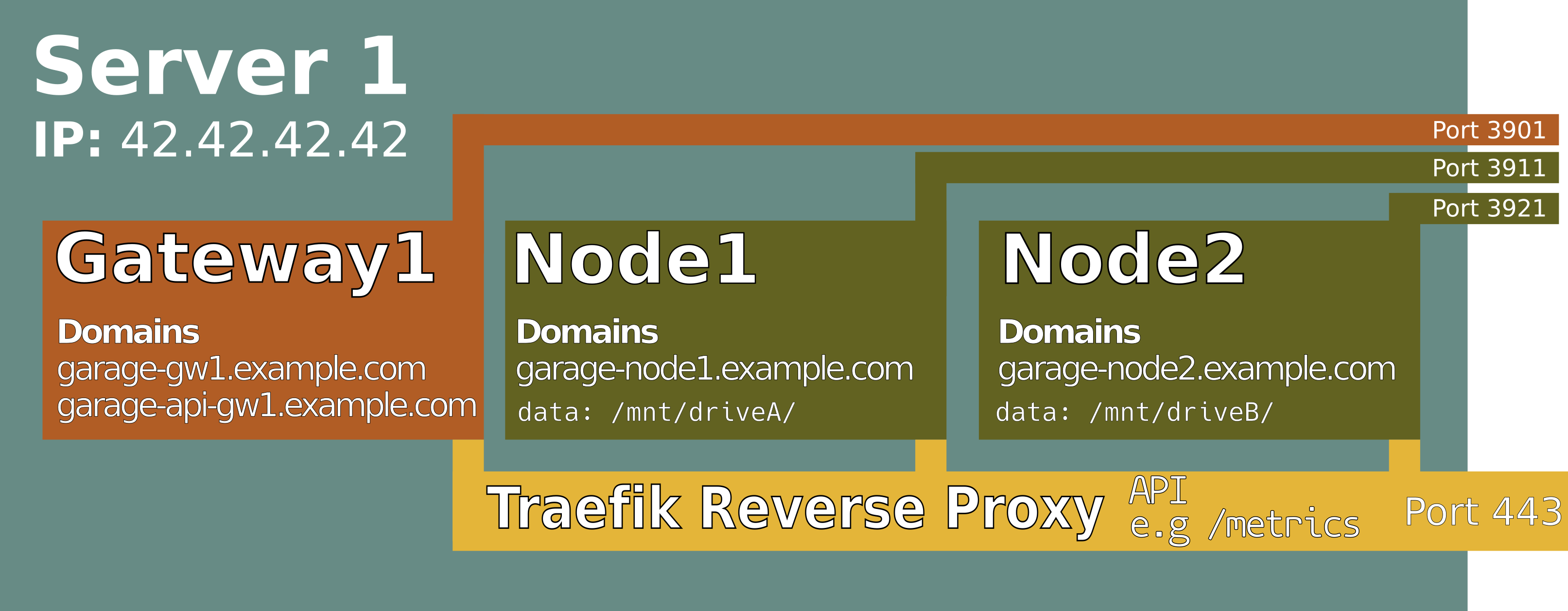I recently build a beginner-friendly ansible playbook for Garage, a S3 compatible distributed object storage.
What is garage-docker-ansible-deploy?
Garage is an open-source distributed object storage service tailored for self-hosting. The ansible playbook garage-docker-ansible-deploy helps you to set up such a cluster.
It comes with “batteries included” so it will automatically install docker and set up a reverse proxy (traefik).
You may be familiar with some related ansible playbooks that this playbook is based on
- matrix-docker-ansible-deploy - for deploying a fully-featured Matrix homeserver
- gitea-docker-ansible-deploy - for deploying a Gitea (self-hosted Git service) server
- vaultwarden-docker-ansible-deploy - for deploying a Vaultwarden password manager server (unofficial Bitwarden compatible server)
These playbooks are masterfully maintained by spantaleev and community. I copied the design und re-use roles e.g. to install traefik.
Opinionated Design
Garage is a very flexible software that can server a lot of use-cases. The playbook is opinionated in the sense that it reduces the flexibility of garage in favor of an easy deployment that should serve common use cases. The playbook currently encourages a layout where
- 1 garage data node is used per physical drive that should be used by the cluster
- 1 gateway node is used per host to make redundant setups possible
Each host is assumed to habe a public IPv4/IPv6 address and every node should have a dedicated subdomain + one subdomain per gateway on the host.
When all of this comes together a garage host might look something like this

Example layout with one host that has 2 nodes (as it has two drives where data will be stored)
The playbook will need you to configure the DNS records to point to server1 and will make everything else happen with the following configuration.
garage_garage_node1_base_path: "/media/drive1/garage/node1"
garage_garage_node2_base_path: "/media/drive2/garage/node2"
garage_garage_nodes:
- name: "gateway1"
metadata_path: "{{ garage_garage_meta_path }}/gw1"
data_path: "{{ garage_garage_data_path }}/gw1"
gateway: true
rpc_bind_port: 3901
node_addr: "garage-gw1.example.com"
s3_api_addr: "s3.example.com"
- name: "node1"
gateway: false
capacity: 3
metadata_path: "{{ garage_garage_node1_base_path }}/metadata"
data_path: "{{ garage_garage_node1_base_path }}/data"
rpc_bind_port: 3911
node_addr: "garage-node1.example.com"
- name: "node2"
gateway: false
capacity: 3
metadata_path: "{{ garage_garage_node2_base_path }}/metadata"
data_path: "{{ garage_garage_node2_base_path }}/data"
rpc_bind_port: 3921
node_addr: "garage-node2.example.com"
Limitations
While the playbook should of course be reusable and fairly modular it will never be a solution to all use cases. The playbook does not cover
- Setting up domains (but there are instructions)
- Detailed management of the buckets and keys: There are basic features to create buckets and access keys but management will not be in the scope of the playbook
- connecting nodes via (mesh) VPN as metioned in the project documentation
Getting started
- Go to the garage-docker-ansible-deploy README with detailed installation instructions
- For any problems you can find help in #garage-docker-ansible-deploy:hyteck.de
- If you think there is something wrong/missing open a GitHub issues: moan0s/garage-docker-ansible-deploy/issues
Be aware that the playbook is not yet used widely so I don’t have much more than my own experiences. I am happy to help if you experience bumps in the road